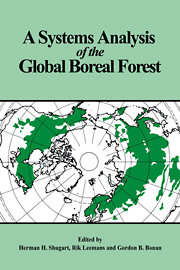Book contents
- Frontmatter
- Contents
- List of contributors
- 1 Introduction
- Part 1 Processes in boreal forests
- Part 2 Patterns in space and time in boreal forests
- Part 3 Computer models for synthesis of pattern and process in the boreal forest
- Introduction
- 12 Individual-tree-based models of forest dynamics and their application in global change research
- 13 Population-level models of forest dynamics
- 14 A spatial model of long-term forest fire dynamics and its applications to forests in western Siberia
- 15 A simulation analysis of environmental factors and ecological processes in North American boreal forests
- 16 The biological component of the simulation model for boreal forest dynamics
- 17 Role of stand simulation in modeling forest response to environmental change and management interventions
- 18 Concluding comments
- References
- Index
12 - Individual-tree-based models of forest dynamics and their application in global change research
Published online by Cambridge University Press: 12 January 2010
- Frontmatter
- Contents
- List of contributors
- 1 Introduction
- Part 1 Processes in boreal forests
- Part 2 Patterns in space and time in boreal forests
- Part 3 Computer models for synthesis of pattern and process in the boreal forest
- Introduction
- 12 Individual-tree-based models of forest dynamics and their application in global change research
- 13 Population-level models of forest dynamics
- 14 A spatial model of long-term forest fire dynamics and its applications to forests in western Siberia
- 15 A simulation analysis of environmental factors and ecological processes in North American boreal forests
- 16 The biological component of the simulation model for boreal forest dynamics
- 17 Role of stand simulation in modeling forest response to environmental change and management interventions
- 18 Concluding comments
- References
- Index
Summary
Introduction
The problem of predicting ecological responses to global environmental change has generated a rich array of scientific challenges for ecosystem ecologists. The International Geosphere–Biosphere Program (IGBP), chartered by the International Council of Scientific Unions in 1986, has as its objective:
‘… to describe and understand the interactive physical, chemical, and biological processes that regulate the total earth system, the unique environment that it provides for life, the changes that are occurring in this system, and the manner in which they are influenced by human activities.’
(International Council of Scientific Unions 1986.)IGBP is one of the most exciting scientific opportunities of our time. The intellectual challenge is ultimately to unify ecological and geophysical sciences at the global scale: a large undertaking in which ecosystem ecology must play a central part.
One of the major tools for this multidisciplinary undertaking will be ecosystem simulation models implemented on high-speed computers. Global dynamics models exist for the atmosphere and oceans as physical systems, but not yet for ecosystems and their interactions with the atmosphere and oceans. This book represents the first attempt to develop a unified model of a major biome (the boreal forest) at the global scale. The model described in the chapters by Bonan (Chapter 15) and Leemans (Chapter 16) belongs to a well-established class of models that simulate the dynamics of forests by projecting the change in size of individual trees over time, through explicit representations of the interactions between arrays of individuals and their local resource environment.
- Type
- Chapter
- Information
- A Systems Analysis of the Global Boreal Forest , pp. 313 - 333Publisher: Cambridge University PressPrint publication year: 1992
- 12
- Cited by



